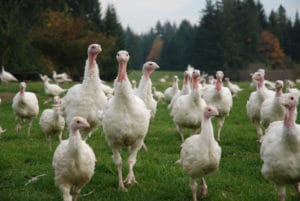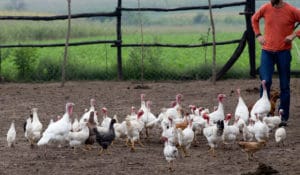By Kelly Klober
The turkey says “America” and “real local food” as do few other things, and varieties are often reflective of specific geographical regions of this nation, the Narragansett of the Northeast and the Bourbon Red of the South.
The producer can play this trump card to the maximum by breeding and raising his or her birds to be marketed directly from the farm. Thirty years ago I visited a Missouri farm where numerous turkey varieties were being propagated well before terms like “local” and “heirloom” filled the pages of food and ag publications. Into 8 x 16-foot, used hog range houses those folks were placing trios of breeding turkeys. The houses were divided in half with a short segment of a 54-inch high cattle panel and each half sheltered a breeding trio. Seven other 16-foot x 54-inch cattle panels were used to create two large pens fronting the Southern-facing house. The pens and shelters had a deep straw litter, a practice old-timers will recall as straw yarding.
Those folks kept four varieties of turkey with between one and three trios of each variety. A few extra breeding birds were kept on hand in case of injury or loss. From their modest numbers and simple housing they produced poults, hatching eggs, breeding stock and table birds for sale. Their houses and panels were bought used, and their main investment in equipment was for a cabinet incubator with a 240-egg capacity.
A friend with a small flock of turkeys has found his niche producing some of the more vividly colored varieties such as the lilac. The poults do not all color up the same, but that challenge is a part of their appeal to him. His sales are generally in quite small numbers to people who first want just a few birds to raise for their own needs and then are drawn to more colorful birds.

When pasturing turkeys with other types of fowl, be aware that turkeys can sometimes be aggressive toward other fowl.
A turkey trio, a tom and two hens, will produce a good number of eggs during a laying season that can begin in early spring and continue into late summer. They won’t lay like Leghorn hens, but a single breeding trio may be all that is needed to fill the local demand for some turkey varieties. Overproduction can undo many local niche markets.
We have had our best results, highest fertility and hatchability with heritage turkeys when keeping them penned as just pairs or trios. With some of the lighter breeds you might stretch that to three or four hens and a tom.

When pasturing turkeys with other types of fowl, be aware that turkeys can sometimes be aggressive toward other fowl.
Other things experience has taught us include:
- Multiple toms in a breeding group will pester and interfere with each other during mating activity and thus reduce fertility.
- For highest fertility and to reduce wear on the hens use only first-year hens.
- With rarer varieties we have used 2-year-old toms, but watch that they have not become too large and cumbersome or that they are wearing on the hens.
- We generally turn hens after two seasons in the breeding pen, but allowances are made for rarer and better performing birds.
- Remove any hens showing excessive wear and back injury. Canvas saddles have been used to protect some hens in the breeding pen.
- Very late-hatched poults will grow more slowly as the days shorten and the weather cools and dampens.
- In evaluating young birds to retain for breeding stock, become familiar with the breeding standards set by the American Poultry Association for your chosen variety or varieties. Select for good type and color, soundness, growth and efficient feed use. In selecting from larger, faster-growing birds in a hatch group, you are selecting for natural health and vigor.
- An adult tom turkey with tail spread and in full strut is one of the most impressive creatures in the farmyard. He is a walking, gobbling advertisement for a most traditional form of agriculture. Think how often their image makes it into news stories and special media features on farm matters. That appeal is something that can be built upon, but consumers moving to purchase an heirloom turkey are going to need much more from the producer to continue that initial warm feeling. The factory-farmed turkey is backed by a one-week hotline the week leading up to Thanksgiving. The successful small flock producer is on the line 24/7/365, breeding, growing, marketing and promoting the better bird.
This article appeared in the November 2012 issue of Acres U.S.A. Klober specializes in raising livestock using natural methods. He is the author of Beyond the Chicken, Talking Chicken, and Dirt Hog, available from Acres U.S.A.

